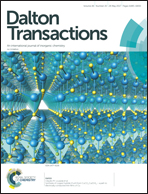Pb2+ complexes of small-cavity azamacrocyclic ligands: thermodynamic and kinetic studies†
Abstract
The synthesis, acid–base behavior and Pb2+ coordination chemistry of the new aza-scorpiand like ligand 5-[2-(N-2-fluorenyl)ethylamino]-2,5,8-triaza[9]-2,6-pyridinophane (L1) have been studied by potentiometry, NMR and spectrofluorimetric titrations, and the results are compared with those obtained for the related compounds L2, lacking the fluorenyl group, and L3, the macrocycle lacking the pendant arm. The crystal structures obtained for complexes [PbL1][PbL1Cl](NO3)Cl2·4H2O (1) and [PbL3](ClO4)2 (2) reveal that the metal ion is located over the plane defined by the nitrogen atoms of the macrocyclic core due to its inability to accommodate the large Pb2+ ion in the macrocyclic cavity. For L1, the secondary amino group of the pendant arm is implicated in the coordination of the metal ion, although the stereoactive lone pair of Pb2+ prevents the closed conformation associated with the coordination of metal ions in aza-scorpiand derivatives. The kinetics of the acid-promoted dissociation of the ligand from the Pb2+ complexes with the three ligands have been studied using stopped-flow with simultaneous absorbance and fluorescence detection. The results indicate that in spite of their similarity, the dissociation of the metal ion occurs with very different rates in the three complexes. During the course of the kinetic studies evidence was obtained for the occurrence of a photochemical process that leads to ligand degradation with the unexpected elimination of one CH2CH2 fragment from the macrocyclic core.



 Please wait while we load your content...
Please wait while we load your content...